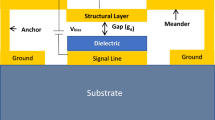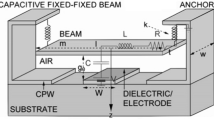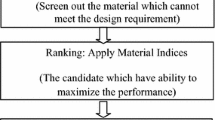Abstract
The micro-electro-mechanical-system switch performance significantly depends on materials used for the design of different components. The two most important elements of the MEMS switch are the beam membrane and dielectric layer. Thus, the selection of a material for these two components should be done with utmost care. In this paper, Ashby’s material selection methodology is employed for choosing the best material for the beam membrane and dielectric layer by investigating a database of materials. The material indices for beam membrane selection are Young’s modulus, Poisson’s ratio, thermal coefficient, electrical resistivity, thermal conductivity, and fracture strength. To obtain the best dielectric material, hold down voltage, dielectric charging, thermal conductivity and stability are considered as material indices to get optimized performance in the switch. To validate the results of material selection using Ashby’s method, the top five selected materials for beam membrane and dielectric are applied on a MEMS switch and impacts of these materials on the electromechanical and RF performance have been presented. The results conclude that the Au and Al2O3 are preferred choice for beam membrane and dielectric material to offer good performance for the frequencies in the range of 50–100 GHz.























Similar content being viewed by others
References
Ansari HR, Taghaddosi MB (2019) Optimization and development of the RF MEMS structures for low voltage, high isolation and low stress. Analog Integr Circ Sig Process 101(3):659–668
Ashby MF, Cebon D (1993) Materials selection in mechanical design. Le J Phys IV 3(C7):C7–C1
Bale AS, Reddy SV, Huddar SA (2020) Electromechanical characterization of Nitinol based RF MEMS switch. Mater Today Proc 27:443–445
Bonthu MK, Sharma AK (2018) An investigation of dielectric material selection of RF-MEMS switches using Ashby’s methodology for RF applications. Microsyst Technol 24(4):1803–1809
Cheulkar LN, Sawant VB, Mohite SS (2020) Evaluating performance of thermally curled microcantilever RF MEMS switches. Mater Today Proc 27:12–18
Demir K, Unlu M (2020) Miniature MEMS: novel key components toward terahertz reconfigurability. Journal of Microelectromech Syst 29:455–467
Deshmukh D, Angira M (2019) Investigation on switching structure material selection for RF-MEMS shunt capacitive switches using Ashby, TOPSIS and VIKOR. Trans Electr Electron Mater 20(3):181–188
Eshaghi M, Rashidzadeh R (2019) A boost converter for energy harvesting utilizing MEMS switch. In: 2019 14th International Conference on Design & technology of integrated systems in nanoscale era (DTIS), pp. 1–4. IEEE
Feng Y, Barker NS (2017) High performance 500–750 GHz RF MEMS switch. In: 2017 IEEE MTT-S International Microwave Symposium (IMS), pp 1095–1097. IEEE
Giacomozzi F, Calaza C, Colpo S, Mulloni V, Collini A, Margesini B, Vietzorreck L (2008) Development of high con coff ratio RF MEMS shunt switches. Roman J Inf Sci Tech 11:143–151
Goldsmith C, Ehmke J, Malczewski A, Pillans B, Eshelman S, Yao Z, Eberly M (2001) Lifetime characterization of capacitive RF MEMS switches. In: 2001 IEEE MTT-S International Microwave Symposium digest (Cat. No. 01CH37157), Vol. 1, pp 227–230. IEEE
Gopalan A, Kommuri UK (2018) Design and development of miniaturized low voltage triangular RF MEMS switch for phased array application. Appl Surf Sci 449:340–345
Gürses E, Akan ÖB (2005) Multimedia communication in wireless sensor networks. In: Annales des Télécommunications, Vol. 60, No. 7–8, pp. 872–900. Springer-Verlag.
Han K, Guo X, Smith S, Deng Z, Li W (2018) Novel high-capacitance-ratio mems switch: design, analysis and performance verification. Micromachines 9(8):390
He XJ, Lv ZQ, Liu B, Li ZH (2012) High-isolation lateral RF MEMS capacitive switch based on HfO2 dielectric for high frequency applications. Sens Actuators A 188:342–348
Huang CY, Chung PH, Shyu JZ, Ho YH, Wu CH, Lee MC, Wu MJ (2018) Evaluation and selection of materials for particulate matter MEMS sensors by using hybrid MCDM methods. Sustainability 10(10):3451
Jaafar H, Sidek O, Miskam A, Korakkottil S (2009) Design and simulation of microelectromechanical system capacitive shunt switches. Am J Eng Appl Sci 2(4):655–660
Jmai B, Anacleto P, Mendes P, Gharsallah A (2018) Modeling, design, and simulation of a radio frequency microelectromechanical system capacitive shunt switch. Int J Numer Model Electron Netw Dev Fields 31(5):e2266
Karthick R, Babu SPK (2020) Review on radio frequency micro electro mechanical systems (RF-MEMS) switch. In: International Conference on communication, computing and electronics systems, pp 437–453. Springer, Singapore
Kumar R (2020) Novel capacitance evaluation model for microelectromechanical switch considering fringe and effect of holes in pull-up and pull-down conditions. Microsyst Technol 26(3):873–884
Kumar R, Pertin O (2019) Design of an improved micro-electro-mechanical-systems switch for RF communication system. In: Khare A, Tiwary U, Sethi I, Singh N (eds) Recent trends in communication, computing, and electronics. Springer, Singapore, pp 3–13
Kundu A, Sethi S, Mondal NC, Gupta B, Lahiri SK, Saha H (2010) Analysis and optimization of two movable plates RF MEMS switch for simultaneous improvement in actuation voltage and switching time. Microelectron J 41(5):257–265
Kurmendra KR (2019a) MEMS based cantilever biosensors for cancer detection using potential bio-markers present in VOCs: a survey. Microsyst Technol 25:3253–3267. https://doi.org/10.1007/s00542-019-04326-1
Kurmendra KR (2019b) Design and simulation of mems shunt capacitive switch for lower switching time. Publ Goal, p 167.
Kurmendra KR (2019c) Design and analysis of MEMS shunt capacitive switch with Si 3 N 4 dielectric and au beam material to improve actuation voltage and RF performance in consideration with and without circular perforations. Trans Electr Electron Mater 20(4):299–308
Kurmendra KR (2020a) A review on RF micro-electro-mechanical-systems (MEMS) switch for radio frequency applications. Microsyst Technol. https://doi.org/10.1007/s00542-020-05025-y
Kurmendra KR (2020b) Novel capacitance evaluation model for microelectromechanical switch considering fringe and effect of holes in pull-up and pull-down conditions. Microsyst Technol 26(3):873–884
Liu Y, Taylor TR, Speck JS, York RA (2002) High-isolation BST-MEMS switches. In: 2002 IEEE MTT-S International Microwave Symposium digest (Cat. No. 02CH37278), Vol. 1, pp 227–230. IEEE
Mafinejad Y, Zarghami M, Kouzani AZ, Mafinezhad K (2013a) Design and simulation of a high isolation RF MEMS shunt capacitive switch for CK band. IEICE Electron Express 10(24):20130746–20130746
Mafinejad Y, Zarghami M, Kouzani AZ, Mafinezhad K (2013b) Impact of carbon material on RF MEMS switch. In: 2013 21st Iranian Conference on electrical engineering (ICEE), pp 1–4. IEEE
Mafinejad Y, Ansari HR, Khosroabadi S (2020) Development and optimization of RF MEMS switch. Microsyst Technol 26(4):1253–1263
Manivannan M, Daniel RJ, Sumangala K (2014) Low actuation voltage RF MEMS switch using varying section composite fixed-fixed beam. Int J Microw Sci Technol
Mehmood Z, Haneef I, Udrea F (2018) Material selection for Micro-Electro-Mechanical-Systems (MEMS) using Ashby’s approach. Mater Des 157:412–430
Mohite SS, Madhewar M, Sawant VB (2018) Modelling and validation of capacitive type RF MEMS switches for low actuation voltage and high isolation. In: Dynamic Systems and Control Conference, Vol. 51890, p V001T13A001. American Society of Mechanical Engineers.
Molaei S, Ganji BA (2017) Design and simulation of a novel RF MEMS shunt capacitive switch with low actuation voltage and high isolation. Microsyst Technol 23(6):1907–1912
Mulloni V, Margesin B, Farinelli P, Marcelli R, Lucibello A, De Angelis G (2017) Cycling reliability of RF-MEMS switches with Gold-Platinum multilayers as contact material. Microsyst Technol 23(9):3843–3850
Naji MK, Farhood AD, Ali AH (2019) Novel design and analysis of RF MEMS shunt capacitive switch for radar and satellite communications. Indones J Electric Eng Comput Sci (IJEECS) 15(2):971–978
Nawaz H, Masood MU, Saleem MM, Iqbal J, Zubair M (2020) Surface roughness effects on electromechanical performance of RF-MEMS capacitive switches. Microelectron Reliab 104:113544
Paldas A, Gupta N (2013) Material selection and parameter characterization for RF MEMS switches. Int J Mech Prod Eng 1(3):7–12
Pertin O (2018) Pull-in-voltage and RF analysis of MEMS based high performance capacitive shunt switch. Microelectron J 77:5–15
Pradell L, Girbau D, Ribó M, Casals-Terré J, Lázaro A, Contreras A, Margesin B (2018) RF-MEMS Switches Designed for High-Performance Uniplanar Microwave and mm-Wave Circuits. MEMS Sens Des Appl, p 117
Qin R, Zhang B, Lei C, Xu Y, Qin J, Fan C, Duan J (2020) A novel switch beam design method with extending switching radio-frequency bandwidth. Microsyst Technol 27:1–10
Rao KS, Kumar PA, Guha K, Sailaja BVS, Vineetha KV, Baishnab KL, Sravani KG (2018) Design and simulation of fixed–fixed flexure type RF MEMS switch for reconfigurable antenna. Microsyst Technol 27:1–8
Ravirala AK, Bethapudi LK, Kommareddy J, Thommandru BS, Jasti S, Gorantla PR, Karumuri SR (2018) Design and performance analysis of uniform meander structured RF MEMS capacitive shunt switch along with perforations. Microsyst Technol 24(2):901–908
Saleem MM, Nawaz H (2019) A systematic review of reliability issues in RF-MEMS switches. Micro Nanosyst 11(1):11–33
Sawant VB, Mohite SS, Cheulkar LN (2018) Comprehensive contact material selection approach for RF MEMS switch. Mater Today Proc 5(4):10704–10711
Saxena A, Agrawal VK (2015) Comparative study of perforated RF MEMS switch. Proc Comput Sci 57:139–145
Sharma AK, Gupta N (2012) Material selection of RF-MEMS switch used for reconfigurable antenna using ashby’s methodology. Progress Electromagn Res 31:147–157
Shekhar S, Vinoy KJ, Ananthasuresh GK (2014) Design, fabrication and characterization of capacitive RF MEMS switches with low pull-in voltage. In: 2014 IEEE International Microwave and RF Conference (IMaRC), pp 182–185. IEEE
Singh T, Khaira N (2014) High isolation single-pole four-throw RF MEMS switch based on series-shunt configuration. Sci World J 2014:1–7
Singh T, Rangra KJ (2015) Compact low-loss high-performance single-pole six-throw RF MEMS switch design and modeling for DC to 6 GHz. Microsyst Technol 21(11):2387–2396
Sravani KG, Guha K, Rao KS (2018) Analysis on selection of beam material for novel step structured RF-MEMS switch used for satellite communication applications. Trans Electr Electron Mater 19(6):467–474
Sravani KG, Narayana TL, Guha K, Rao KS (2018) Role of dielectric layer and beam membrane in improving the performance of capacitive RF MEMS switches for Ka-band applications. Microsyst Technol, pp 1–10
Srihari G, Shanmuganantham T (2020) Reconfigurable RF MEMS switch with improved switching speeds using push pull configuration. Helix 10(03):42–46
Tavassolian N (2011) Dielectric charging in capacitive RF MEMS switches with silicon nitride and silicon dioxide. Doctoral dissertation, Georgia Institute of Technology
Thalluri LN, Guha K, Rao KS, Prasad GVH, Sravani KG, Sastry KSR, Babu PB (2020) Perforated serpentine membrane with AlN as dielectric material shunt capacitive RF MEMS switch fabrication and characterization. Microsyst Technol 26:1–13
Van Spengen WM (2012) Capacitive RF MEMS switch dielectric charging and reliability: a critical review with recommendations. J Micromech Microeng 22(7):074001
Wang Y, Li Z, McCormick DT, Tien NC (2004) A low-voltage lateral MEMS switch with high RF performance. J Microelectromech Syst 13(6):902–911
Wang G, Polley T, Hunt A, Papapolymerou J (2005) A high performance tunable RF MEMS switch using barium strontium titanate (BST) dielectrics for reconfigurable antennas and phased arrays. IEEE Antennas Wirel Propag Lett 4:217–220
Wei H, Deng Z, Guo X, Wang Y, Yang H (2017) High on/off capacitance ratio RF MEMS capacitive switches. J Micromech Microeng 27(5):055002
Wei H, Jia S, Zhao F, Dang L, Liang G, Xu Y, Deng Z (2019) A new RF MEMS capacitive switch for K-band application. Progress Electromagn Res 93:253–263
Yuan X, Cherepko S, Hwang J, Goldsmith CL, Nordqusit C, Dyck C (2004) Initial observation and analysis of dielectric-charging effects on RF MEMS capacitive switches. In: 2004 IEEE MTT-S International Microwave Symposium digest (IEEE Cat. No. 04CH37535), Vol. 3, pp 1943–1946. IEEE
Zaghloul U, Papaioannou G, Coccetti F, Pons P, Plana R (2009) Dielectric charging in silicon nitride films for MEMS capacitive switches: effect of film thickness and deposition conditions. Microelectron Reliab 49(9–11):1309–1314
Zhang K, Zhan J, Yao Y (2019) TOPSIS method based on a fuzzy covering approximation space: An application to biological nano-materials selection. Inf Sci 502:297–329
Zhang N, Yan Z, Song R, Wang C, Guo Q, Yang J (2019) Design and performance of a J band MEMS switch. Micromachines 10(7):467
Ziko MH, Koel A (2018) Design and optimization of AlN based RF MEMS switches. Smart Eng Mater 362:1–9
Author information
Authors and Affiliations
Corresponding author
Additional information
Publisher's Note
Springer Nature remains neutral with regard to jurisdictional claims in published maps and institutional affiliations.
Rights and permissions
About this article
Cite this article
Kurmendra, Kumar, R. Investigations on beam membrane and dielectric materials using Ashby’s methodology and their impact on the performance of a MEMS capacitive switch. Microsyst Technol 27, 4269–4289 (2021). https://doi.org/10.1007/s00542-021-05220-5
Received:
Accepted:
Published:
Issue Date:
DOI: https://doi.org/10.1007/s00542-021-05220-5




